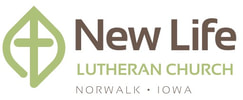What To Expect
New Life gathers for worship weekly on Sunday mornings at 9:30. We are a casual community of faith. Our music will alternate between Traditional Hymns and Contemporary Christian throughout the month.
We hope that you will join us this weekend!
We hope that you will join us this weekend!
The Church Year

Human life is lived in time and we mark time in many ways. The most common cycles for living, into which we divide time, are days and weeks and years. The daily cycle provides our rhythm for life with its hours of darkness and light, dawn and dusk, waking and sleeping, working and playing. The week is made up of a cycle of seven days and most of us organize our live around these days. Healthy patterns of living include work time and play time, time for productivity and time for recreation and relaxation. Combining 52 of these weeks gives us the cycle of a year with its celebrations of birthdays and anniversaries, its beginnings and endings, its rotation of the seasons…spring, summer, autumn and winter.
Another unique way of marking time for Christians is the church year. We who live in the 21st century have inherited a year that has become richer and fuller through the ages since the forth century when the Christian church year began to develop. The Lutheran Book of Worship (LBW) divides the liturgical year into three main periods that help us remember the birth, life and death of Jesus.
The Christmas Cycle
The Christmas Cycle, with its seasons of Advent, Christmas and Epiphany marks the beginning of the church year. It celebrates the events surrounding Christ’s coming.
Advent is celebrated on the four Sundays prior to Christmas as we hear the prophecies that foretold Jesus coming into the world.
Christmas announces Jesus birth and celebrates the mystery of the Word become flesh. The Christmas season is 12 days long and ends on January 6 with the Epiphany of our Lord.
Epiphany celebrates Jesus manifestation to the Gentiles and marks his baptism and the beginning of his public ministry.
The Easter Cycle
The Easter Cycle with its seasons of Lent, Holy Week and Easter celebrates the events surrounding Christ’s passion, death and resurrection.
Ash Wednesday opens this season with a call to the penitential disciplines of prayer, fasting, and performing acts of kindness. Ashes mark the sign of the cross on our foreheads reminding us that we are dust, and to dust we will return.
The weeks of Lent follow Ash Wednesday and are weeks intended for renewal and reawakening to the possibilities of God. We worship together on Wednesday evenings during Lent, opening ourselves to the mystery of God and preparing for the Lords passion.
Holy Week begins on Sunday with a procession of palms. We gather together on Maundy Thursday to begin what is really “The Three Days” that are at the heart and center of the church’s communal life. We travel as pilgrims from death to resurrection. This Thursday evening service reminds us of Jesus’ last meal with his disciples when he washed their feet and invited them into a kingdom where greatness is measured by how willingly you serve. Good Friday is celebrated by a service of darkness that calls us to remember that Jesus died willingly on the cross for love of us. Easter Sunday morning is a joyfilled occasion that celebrates the empty tomb, marking the resurrection of Jesus, and the promise of life eternal. The Easter season lasts a week of weeks (49 days) and ends on Pentecost Sunday. Throughout this season the Holy Spirit enfolds us in the garments of new life and empowers us to live resurrection possibilities. The celebration of the Ascension falls during the Easter season. Pentecost Sunday marks the end of the first half of the Christian church year and its focus on the birth, life and death of Jesus Christ.
Ordinary Time
The Sundays after Pentecost mark the second half of the church year, a time we call “ordinary time,” or simply the days after Pentecost. We are called during this second half of the church year to focus and reflect on how to be the church, the living body of Christ in the world. From Advent to Pentecost our focus was on Jesus and the amazing reality of his coming to be our Immanuel…God with us. Now, in the season of Pentecost we change our focus and seek to answer the questions, “How our we to live in response to the good news that God has come to us?” and “How will our lives reflect the truth that Christ has been raised and the power of his Spirit resides in us?” This focus on Christ centered lives and spirit powered living continue throughout the second half of the church year until we once again return to Advent and begin again the cycle that renews our faith and calls us to discipleship.
Another unique way of marking time for Christians is the church year. We who live in the 21st century have inherited a year that has become richer and fuller through the ages since the forth century when the Christian church year began to develop. The Lutheran Book of Worship (LBW) divides the liturgical year into three main periods that help us remember the birth, life and death of Jesus.
The Christmas Cycle
The Christmas Cycle, with its seasons of Advent, Christmas and Epiphany marks the beginning of the church year. It celebrates the events surrounding Christ’s coming.
Advent is celebrated on the four Sundays prior to Christmas as we hear the prophecies that foretold Jesus coming into the world.
Christmas announces Jesus birth and celebrates the mystery of the Word become flesh. The Christmas season is 12 days long and ends on January 6 with the Epiphany of our Lord.
Epiphany celebrates Jesus manifestation to the Gentiles and marks his baptism and the beginning of his public ministry.
The Easter Cycle
The Easter Cycle with its seasons of Lent, Holy Week and Easter celebrates the events surrounding Christ’s passion, death and resurrection.
Ash Wednesday opens this season with a call to the penitential disciplines of prayer, fasting, and performing acts of kindness. Ashes mark the sign of the cross on our foreheads reminding us that we are dust, and to dust we will return.
The weeks of Lent follow Ash Wednesday and are weeks intended for renewal and reawakening to the possibilities of God. We worship together on Wednesday evenings during Lent, opening ourselves to the mystery of God and preparing for the Lords passion.
Holy Week begins on Sunday with a procession of palms. We gather together on Maundy Thursday to begin what is really “The Three Days” that are at the heart and center of the church’s communal life. We travel as pilgrims from death to resurrection. This Thursday evening service reminds us of Jesus’ last meal with his disciples when he washed their feet and invited them into a kingdom where greatness is measured by how willingly you serve. Good Friday is celebrated by a service of darkness that calls us to remember that Jesus died willingly on the cross for love of us. Easter Sunday morning is a joyfilled occasion that celebrates the empty tomb, marking the resurrection of Jesus, and the promise of life eternal. The Easter season lasts a week of weeks (49 days) and ends on Pentecost Sunday. Throughout this season the Holy Spirit enfolds us in the garments of new life and empowers us to live resurrection possibilities. The celebration of the Ascension falls during the Easter season. Pentecost Sunday marks the end of the first half of the Christian church year and its focus on the birth, life and death of Jesus Christ.
Ordinary Time
The Sundays after Pentecost mark the second half of the church year, a time we call “ordinary time,” or simply the days after Pentecost. We are called during this second half of the church year to focus and reflect on how to be the church, the living body of Christ in the world. From Advent to Pentecost our focus was on Jesus and the amazing reality of his coming to be our Immanuel…God with us. Now, in the season of Pentecost we change our focus and seek to answer the questions, “How our we to live in response to the good news that God has come to us?” and “How will our lives reflect the truth that Christ has been raised and the power of his Spirit resides in us?” This focus on Christ centered lives and spirit powered living continue throughout the second half of the church year until we once again return to Advent and begin again the cycle that renews our faith and calls us to discipleship.

